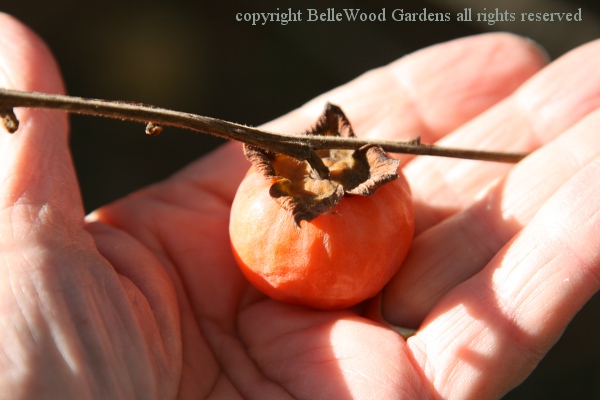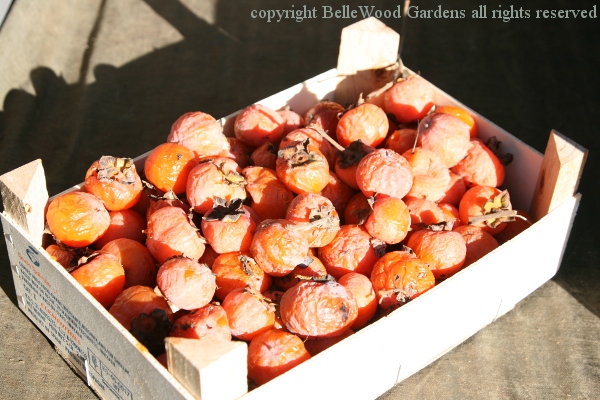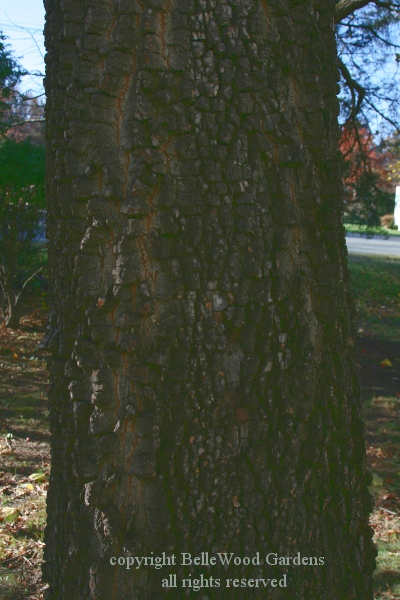
.
If you have any comments, observations, or questions about what you read here, remember you can always Contact Me
All content included on this site such as text, graphics and images is protected by U.S and international copyright law.
The compilation of all content on this site is the exclusive property of the site copyright holder.

Look what I found!
There's this house I drive by, on a busy road. Every fall there are these two big trees bedecked with orange fruit. I know what they are. I do, I do! They're persimmons, our native persimmon, Diospyros virginiana. What has me so excited is that they're delicious to eat - if, that is, you wait until they're mushy ripe. An unripe persimmon is the most mouth-puckering astringent thing you could ever find. The stores have the larger Asian persimmons for sale, D. kakai. But the only way to enjoy our native fruit is to go out and forage for it.
And every year I'd think I really should stop at the house on the side of the busy road. Traffic would be congested and I had places to go and things to do. And I didn't stop. This year, I decided, this year would be different. I'd go on a Sunday, when people would be likely to be home. And even if they didn't want to share the fruit I could at least get some pictures of the trees.

The day was sunny, bright, and incredibly windy. Leaves were showering off trees and scudding across the ground. Persimmons too, I'm afraid. A glance at the branches showed less fruit than just a few days ago.

I knocked at the door. Spoke to the people - tenants, I think they are. Sure, go ahead, take pictures, pick up persimmons off the ground if I wanted any. Edible? Had no idea. And no interest in sampling them, apparently. Took my pictures, and filled a little box that I had in my car. And ate some too - sampling for quality I told myself.

Persimmons are native from New Jersey and southeastern Pennsylvania down as far south as Florida and west as far as eastern Texas. Bobby's folks had a farm in North Carolina. "Mama made persimmon pudding." he said. "Trees were abundant down on the farm." And my friend James grew up down South. He thinks "They're beautiful. My grandmother had persimmons on her land. I don't know whether I like eating them more or seeing them on the trees. Are you cooking with them?" I'm giving him some seeds that he's going to direct plant in two or three places on his property, to stratify and come up next Spring. The important thing will be to plant them where they are to grow, as persimmon seedlings have a deep tap root.
That may be why they are not offered for sale. A pity, as - in addition to delicious fruit our native persimmon has an attractive shape, is little troubled by disease or pests. And has a fascinating, deeply checkered, alligator-like bark.

Before going home I went to the Bouman-Stickney Museum in Readington Township for another of their open hearth cooking demonstrations. I gave a few persimmons to Connie Unangst, who was cooking. Persimmons were a favorite food of Native Americans, and I'm sure the colonists also appreciated them. There was a couple in the audience who were very interested in these little orange fruits. There are some trees on their property and they had not been able to get them identified. Someone thought they might be quinces. Totally off the mark - quince is a very hard fruit, inedible until cooked. If I had to choose something even somewhat similar I'd go for a medlar. Which is not native and rarely seen in our gardens. But now they know what it is, and what the three adolescent bears were scoffing down last year. Persimmon has very high value for wildlife. As well as being enjoyed by people, raccoons and opossums like it too.
That evening, after dinner, I processed the very soft fruit. Rinsed them clean and simply pureed them through a food mill. From the approximately 150 soft mushy correct-stage little fruits the yield was four 2-cup bags of persimmon puree. The puree was not blanched or treated in any way. I did add a teaspoon of Fruit Fresh well stirred into each bag, and straight into the freezer. Persimmon pudding will be on the Thanksgiving menu.
Cleaned up, and e-mailed some friends, to tell them of my foraging find. And also to ask if they wanted any seeds.

Each little fruit has several seeds, you see, and persimmons are apparently easy to raise from seed. It's nice to grow our native plants. While they like a damp-ish site they are adaptable, and will begin bearing at 6 years from seed. Flowers are supposed to be fragrant. You do need several, as trees are dioecious, male and female on different trees, like hollies. Let me know, I said, if you are interested. And everyone was.
Michael said, "Hey Judy. Yes. Thank you. So where are there native persimmon around here? I keep my eye out but never see them. "
Joan told me she planted some a couple of years ago, and got something like 14 germinating out of 15 seeds. She added that today she "Planted the seeds & they are nestled in my outdoor cage - well protected from gnawing critters. We'll see what shows up come spring."
Ditto for me. Gardeners are always looking ahead. It's wonderful.
Back to Top
Back to November 2014